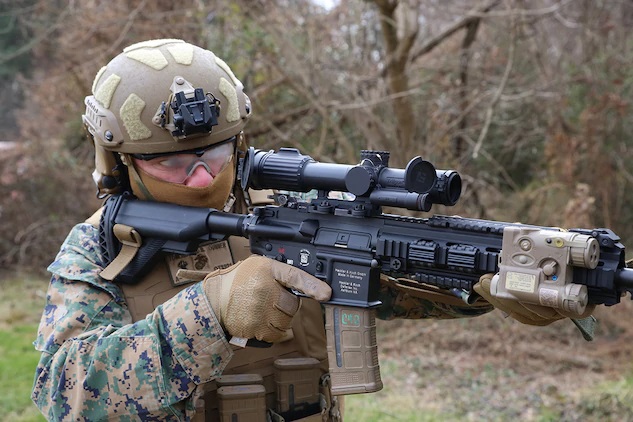1911 Syndicate has a fun video with my buddy James Williamson featuring the Marines breakout infantry toy, the M27 IAR.
If you don’t want to watch the video, well… sad. It’s fun and informative and has neat guns.
But if you don’t, here is a Marine’s perspective in text on how the M27 snuck in. I’ve said it before in parts but it was really clever and the Marine command will never admit to it.
As you know if yo’ve watched the NGSW process, getting a new service weapon is a ginormous (technical term) task. The monumentally laborious and detailed process is designed to ensure fairness in the request and a detailed list of requirements.
The Marines didn’t have time for that. We aren’t patient.

So the USMC went to the procurement folks and asked for a “supplemental” weapon for the M249 because the M249 was problematic in many ways. This was and is true. The SAWs are heavy cumbersome light machine guns that haven’t benefitted from the glow ups that the AR-15 has had in the last couple decades. They do not have a open market presence, there are far fewer units in circulation in total, and so it was kinda left alone after they put an optic rail on the top cover.
It remained heavy, cumbersome, and difficult to manage. So all of these very real problems with using the SAW made it into the request for a lighter magazine fed weapon to “supplement” the SAW. *wink*
So a request went out. Colt, LWRCi, FN, and H&K sent in some pretty cool rifles. My personal favorite was the LWRCi M6A3 which would switch to open bolt as it got hot. That was really cool.
When you look at the data the FN SCAR variant was probably the functionally objective winner, however logistically the USMC picked the H&K 416 variant.
Thus came out the M27, which filled a size gap between the M16A4 and M4/M4A1 and improved on many of the complaints those weapons received during the timeframe. Weird that it did that when it was supposed to improve on the SAW.
Then after a bit the M27 was purchased in a much larger contracted amount by the Marines and declared to be the standard ground forces fighting rifle. It brought a super robust operating system, a floated and accurate barrel, a better sling, and improved controls and interface. All, again, improvements on the M16A4 and M4, not really the SAW.
There continues to be significant and well supported dissent over the decision to remove light machine guns from the infantry squads and rely on medium machine guns for sustained firepower. There are arguments either way, and the procurement of the XM250 by the US Army may influence that in the next few years (there is a 5.56 variant of that machine gun from SIG, so).
So the path chosen was not to upgrade the M16A4 to the A5. The M4 was a quick interchanged solution but the not spoken aloud was the clear intent to put the M27 with a Trijicon LPVO VCOG into place as a nicely modernized rifle.
The question now is where does the modernizing force go next? Their rifle works well, the M4’s do too. They’re pretty well set there for a minute. But if the Army goes hard on 6.8×51 and it is working out the Marines will likely be compelled to follow suit, as they were on M855A1 instead of Mk318.
The other option that I haven’t seen explored is a simple PIP to use higher pressure 5.56 NATO using the same case technology SIG has for the 6.8. Being able to add 30-50% pressure and up the muzzle velocities on heavier projectiles could provide excellent results too.
We shall see.
The USMC has been upgrading a great deal of their gear independent of the US Army since then and it is good to see the force being equipped as their mission set dictates. I’ll probably enjoy the projects until I’m senile.
Anyway, thanks reading. Enjoy the video. Give it a like.



